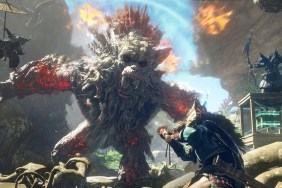Korean American, Chinese American, Japanese American: What's The Difference?!
Normally, previews are as straightforward as a fact sheet with fluff around it, and I get straight to the nitty-gritty of the game at hand. But this time, I'm going to get racial. And I'm not going to let it go, because Homefront doesn't either. The background story and American backyard setting are what separates Homefront from all the other modern first-person shooters on the market, so any lingering concerns about the story feels appropriate, as awkward as it might be.
[image1]During my attendance at the unveiling of THQ Montreal and the single-player campaign for Homefront by Kaos Studios, I realized that among the crowd of Canadian and American journalists and game designers, I was one of only two Asians at the event. (I squinted really hard.) In an atmosphere where people were observing and gleefully playing a first-person shooter about Americans defending their fatherland in 2027 against invading "Axis of Evil" North Koreans, in the form of the Korean People's Army (Korea fictionally unified), I was unsettled to say the least. This paranoid fantasy nightmare made into virtual reality is not too far from political "patriotic" propaganda spewed by some news networks that shall remain nameless, and it calls into question how far a game can call upon the real world in the name of fun.
As I am Chinese-American – or by my terms, American-Chinese, or straight-up American depending on the question you ask me – you might be scratching your head as to why I'm getting all uppity on the premise behind Homefront. Well, apart from the underlying fact that most Americans can't tell the difference behind us Asians in the first place, China might as well have been the invading force instead of North Korea – what with outscourcing, China's rapid economic growth, Chinese investors getting their hands on American companies and real estate, and American gangsters getting tattoos of Chinese characters that they don't understand.
It was not too long ago that the American government imposed Japanese internment camps during World War II, a time when some Japanese Americans like Fred Kotematsu posed as Chinese citizens to escape. It's an act that the US government is still apologizing for, in part by giving money to Japanese Americans who survived the ordeal. Thus, Homefront's speculative fiction provokes the question of whether Americans would repeat the same mistake against Korean-Americans, and if Korean-Americans would react the same way as Japanese-Americans did back then. Considering that this is a first-person shooter, a genre not necessarily known for tact when it comes to racial issues, I was dubious.
[image2]So color me surprised to learn that the writers have gone to such lengths as to include the concept of the Racial Wars. The extent of which the game delves into the American response to Korean-Americans is not as certain as that of the upcoming novel Homefront: The Voice of Freedom, but one of the side characters in the hands-on demo includes Hopper, a Korean mechanic in the resistance who has gone through the Racial Wars and has a scar to prove it. Certainly, I shouldn't be too surprised about this kind of detail when John Milius, a co-writer for Apocalypse Now and Red Dawn, is the head writer for the story, and that Tae Kim, a former CIA field agent, consulted on it. In Tae Kim's defense, it was not his intention to create propaganda against North Koreans, though the unintentional effect is overwhelmingly obvious.
I expect most critics and journalists to tiptoe around this touchy subject, for good reason, especially when there are so many other plausible doomsday events in Homefront's speculative timeline to focus on: North Korea's annexation of South Korea and Japan, the incompetence of The United Nations, the financial crumbling of American banks, a communications satellite firing a continent-wide EMP blast on America. Any one of these events can spark an editorial all its own, putting the supposed American reaction to the Asian community on the backburner. But I contend that the most compelling and dramatic story in Homefront's universe would be a story about a patriotic Korean-American who experiences the Racial Wars firsthand, defending his family and himself against discrimination, and is then drafted into the military to defend his country.
Of course, let's not get too off-track on what the game is about. The point of all these conspiracy theories is to justify defending one's country against foreign invaders on home soil. It's about your homes razed to the ground, your schools turned into enemy military bases, your Full Throttle soda machines toppled over to provide cover, your children being caught in the blast of "a tactical strike", and your neighbors beaten, cuffed, and killed like dogs on the street. It's about a general American soldier and citizen – in this case, a man named Robert Jacobs in Montrose, Colorado whose skills as a helicopter pilot puts a target on his back – answering the call of resistance to protect humble apple pie from the supposed threat of kimchi.
[image3]This might sound strange, but talking about the first-person shooter gameplay isn't that important here – not because it's flawed in any obvious way, but that it's expected. You can aim down your sights, reload, lay prone, sprint, crouch behind cover, and lob grenades. The linear route from one highlighted objective to the next is clear and straightforward, whether that means popping headshots from the broken windows of a convenience store, or protecting a mother and child from enemy fire. The only main point of distinction here is that you'll employ guerrilla-styled tactics, picking up your enemy's weapons often since ammo is in short supply.
As for multiplayer, expect a cross between Battlefield: Bad Company 2 and Modern Warfare 2, except with the addition of Battle Points. Earned by getting kills and capturing locations, Battle Points allow players to spend them at any time to purchase vehicles, refill ammo, and radio in for air strikes at the touch of the D-pad. Also, there are several classes to choose from, though they don't differ too much from each other, and up to 16-vs.-16 matches on maps that pit Americans against the Greater Korean Republic. Another note is that you can spawn into a new or teammate's vehicle instantly; I'm not sure if this is going to survive after the demo's pre-alpha stage, but it's cool nonetheless.
Time will tell whether Homefront will be criticized by the Korean community in America. There may come a resolution along the lines of "Opposing Forces", but I predict that since we don't have any military troops traumatized or fighting against the North Koreans (yet), Homefront will be at best an uncanny portent of the future. But regardless of its worth as an interactive crystal ball, it's already shaping up to be a fighting force in the video game world when it arrives March 8th, 2011.







